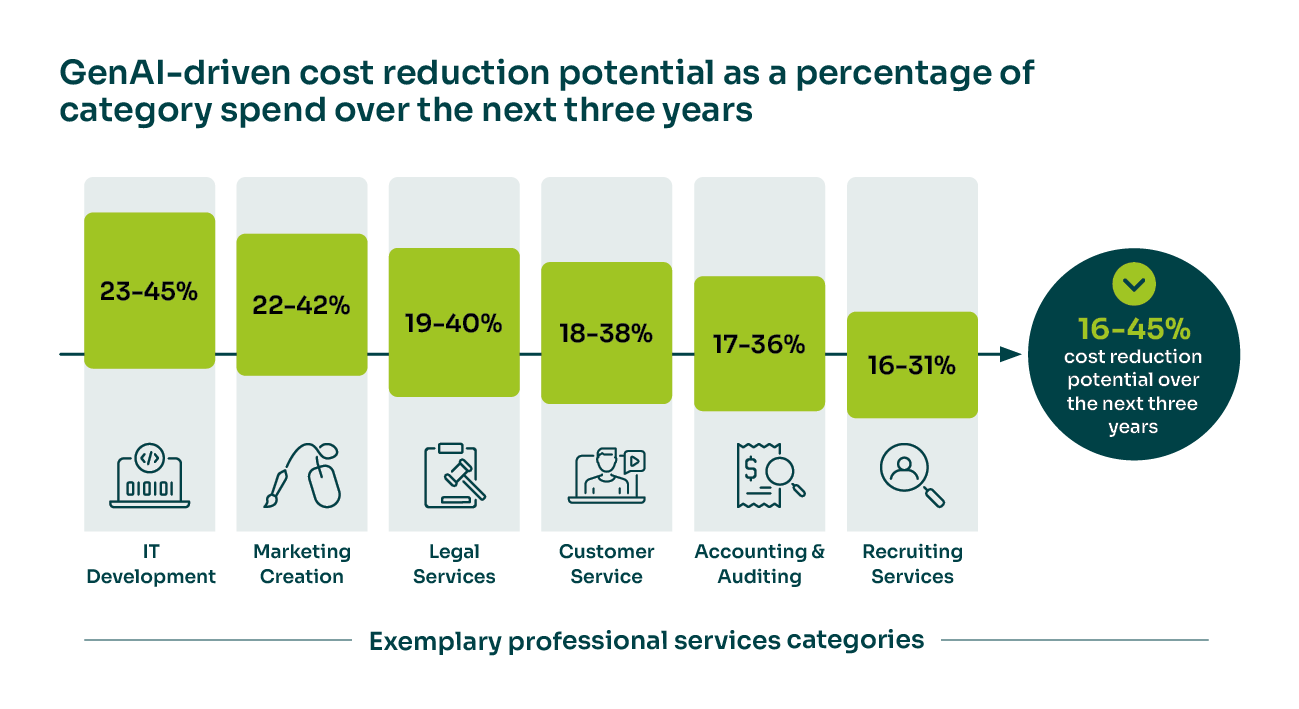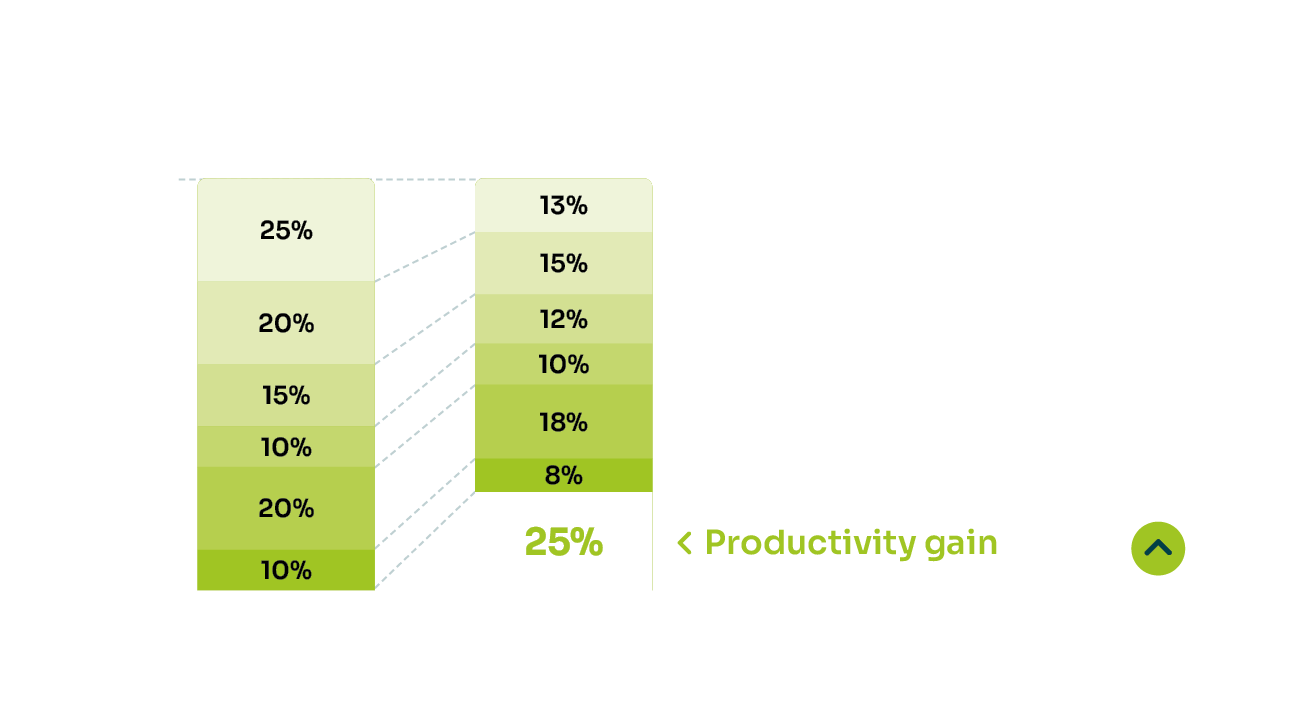GenAI
The use of (Gen)AI in procurement enables smarter and more effective procurement processes.
GenAI is reshaping professional services delivery – automating tasks, accelerating timelines, and reducing costs for suppliers. Yet, many procurement functions have not anticipated GenAI-driven efficiencies. While providers boost efficiency through GenAI, buyers have a clear opportunity to translate these productivity gains into cost savings. In key categories like IT development, legal services, and recruiting, up to 45% of external spend could be reduced over the next three years – if procurement teams act now.

Productivity Gains

Cost Reduction Potential Over the Next Three Years
To capture this value, buyers must rethink sourcing strategies. That means identifying where GenAI is deployed, understanding its impact on supplier cost structures, and actively renegotiating terms. This article outlines how procurement leaders can move from awareness to action – using data-driven methods to unlock savings and build a GenAI-ready supplier base.
GenAI is fundamentally changing how professional services are delivered. In categories like IT development, legal services, and recruiting, where work is language- and logic-driven, GenAI automates tasks such as drafting, coding, and screening, enabling 30%–70% productivity gains at the task level.
For buyers, this shift creates real savings potential. As providers reduce delivery time and labor intensity, procurement can leverage these efficiency gains to renegotiate costs and reshape sourcing strategies.

Not all professional services work is equally automatable. GenAI delivers the greatest impact in repetitive, structured tasks like code generation, document drafting, research, and admin work. These “AI-friendly” activities can often be executed faster and more accurately, freeing up time and reducing the need for senior input.
Take three representative roles:
These shifts don’t just improve supplier productivity, they reshape the delivery model and cost base. For procurement, understanding time allocation by task is critical. It enables data-driven discussions with suppliers and forms the basis for category-level savings estimations.
GenAI isn’t just boosting productivity, it’s transforming cost structures. By analyzing how much time is spent on automatable tasks and linking that to supplier personnel costs, organizations can estimate how much of their external spend is actually up for renegotiation.
A bottom-up analysis by Boston Consulting Group (BCG) shows cost reduction potential of 16% to 45% across key professional services categories over the next three years:

// Source: BCG
These estimates assume stable non-personnel costs, making them directly translatable into procurement savings. The faster procurement teams assess where and how GenAI is impacting delivery, the sooner they can move from broad estimates to fact-based negotiations grounded in real supplier cost savings.
The first step to unlocking GenAI-driven savings is identifying where value can be captured today. In many categories, GenAI tools are already in use by suppliers. Procurement teams should prioritize these areas.
A practical approach begins with:
Targeting high-impact categories like IT development, legal services, and recruiting where GenAI maturity and automation potential are already high.
Assessing supplier readiness using structured criteria, such as:
Armed with this insight, buyers can initiate fact-based renegotiations. Tools like should-costing help break down delivery components—highlighting where GenAI reduces effort and cost. Early engagement with suppliers (e.g. supplier days or workshops) can accelerate alignment and uncover quick-win opportunities, while also reinforcing governance expectations around AI use.
To fully realize the potential of GenAI across professional services, procurement must reshape sourcing strategies for the long term. This means going beyond renegotiation and actively designing a supplier ecosystem that is fit for a GenAI-enabled future.
Long-term value comes from strategic choices across several dimensions:
These levers are most effective when grounded in real supplier insights and category-level automation potential. For procurement, success will depend not just on negotiating better terms, but on challenging the status quo and enabling GenAI at scale across the supply base.




Capturing GenAI Savings in IT Procurement
In many organizations, software development is one of the largest areas of professional services spend. GenAI tools, such as code generators and automated testing assistants, are increasingly embedded into supplier workflows, allowing developers to complete tasks faster and with fewer resources.
Procurement teams that take the time to assess how GenAI is used across their supplier base often uncover significant gaps between delivery efficiency and current pricing models. By analyzing activity-level cost structures and identifying which tasks are now partially or fully automated, buyers can build a clear business case for renegotiation.

// Source: BCG Henderson Institute
In one case, rebaselining delivery costs based on GenAI-enabled productivity led to a 15% reduction in rates, alongside a shift in volume toward more automation-ready suppliers. The result: faster delivery at lower cost without compromising on quality.

Leveraging GenAI in Legal Services Procurement
Legal services often involve structured, document-heavy tasks, such as research, drafting, and contract review. These areas are particularly well suited for GenAI, which can rapidly generate first drafts, extract key clauses, and assist in regulatory interpretation. By reviewing deliverables and time allocations, buyers can open a fact-based discussion on pricing and effort.

// Source: BCG Henderson Institute
In practice, this has enabled organizations to challenge standard rates for routine document work and secure blended pricing models that reflect increased automation and reduced time requirements. In some cases, buyers also began partnering with legal providers to pilot GenAI tools, creating a pathway for further savings and innovation.

Unlocking Efficiency in Recruiting Services
Recruiting is traditionally a time-intensive process, involving scheduling, screening, and documentation, tasks that are ideal candidates for GenAI automation. Tools now enable faster candidate shortlisting, automated outreach, and even first-round assessments.
Mapping recruiting workflows can uncover areas where GenAI tools are already reducing workload, even if billing models haven’t yet caught up. By comparing delivery models across providers, they can identify those with higher GenAI adoption and negotiate improved terms or performance-linked fees.

// Source: BCG Henderson Institute
In several cases, buyers achieved both cost reductions and service enhancements by shifting volume to providers that used automation to accelerate candidate pipelines, leading to faster time-to-hire and lower per-placement costs, especially in high-volume recruiting environments.

GenAI is already transforming how professional services are delivered but only forward-looking procurement teams will turn this shift into measurable savings. With up to 45% cost reduction potential on the table, the opportunity is too large to ignore.
By acting now, procurement can move from passive observer to active value creator. The organizations that do will not only lead on cost but help shape the future of high-skill service delivery.
Discover how Inverto helps translate GenAI’s potential into real impact on Indirect Spend.